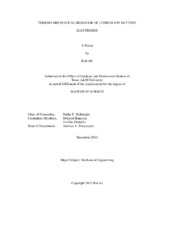| dc.contributor.advisor | Mukherjee, Partha P | |
| dc.creator | An, Kai | |
| dc.date.accessioned | 2014-05-13T17:27:48Z | |
| dc.date.available | 2015-12-01T06:31:21Z | |
| dc.date.created | 2013-12 | |
| dc.date.issued | 2013-11-25 | |
| dc.date.submitted | December 2013 | |
| dc.identifier.uri | https://hdl.handle.net/1969.1/151869 | |
| dc.description.abstract | Developing electric vehicles is widely considered as a direct approach to resolve the energy and environmental challenges faced by the human race. As one of the most promising power solutions to electric cars, the lithium ion battery is expected to achieve better performance, durability and safety. Fracture induced by lithiation and deliathiation stress has been identified as a major mechanism that leads to capacity loss and performance degradation.
This work aims to shed light on the thermo-mechanical behavior of lithium ion battery electrodes. It presents a single particle model of random lattice spring elements coupled with solid phase Li-ion diffusion under active temperature effects. The thermal features are realized by solving a lumped heat conduction equation and by including temperature dependent parameters. This model combined with a typical equivalent-circuit model is used to predict the impedance response of electrode particles.
The fracture generation increases as the temperature decreases. However, the diffusion induced fracture is found to be proportional to the current density and particle sizes. Simulations under realistic driving conditions show that the fraction of particle damage is determined by the highest current density drawn from the battery. A 3D phase map of fracture damage is presented.
The transit fracture growing process reveals a saturation phenomenon where the fraction of damage increases to a threshold value and then stabilizes. This is observed both during single discharging processes and in multiple cycle simulations. In the multicycle analysis, the charging process following the initial discharging leads to a “re-saturation” where the fracture experiences a second increase and then stops growing ever after.
The impedance study suggests that the generation of fracture leads to increase in impedance response of electrode particles. The calculated impedance results are found to be directly related to current density and particle size but drops with increasing temperatures. | en |
| dc.format.mimetype | application/pdf | |
| dc.language.iso | en | |
| dc.subject | Lithium-ion battery | en |
| dc.subject | Thermo-mechanical behavior | en |
| dc.subject | Single particle | en |
| dc.subject | Fracture | en |
| dc.subject | Diffusion induced stress | en |
| dc.subject | Impedance | en |
| dc.title | Thermo-mechanical Behavior of Lithium-ion Battery Electrodes | en |
| dc.type | Thesis | en |
| thesis.degree.department | Mechanical Engineering | en |
| thesis.degree.discipline | Mechanical Engineering | en |
| thesis.degree.grantor | Texas A & M University | en |
| thesis.degree.name | Master of Science | en |
| thesis.degree.level | Masters | en |
| dc.contributor.committeeMember | Banerjee, Debjyoti | |
| dc.contributor.committeeMember | Efendiev, Yalchin | |
| dc.type.material | text | en |
| dc.date.updated | 2014-05-13T17:27:48Z | |
| local.embargo.terms | 2015-12-01 | |


